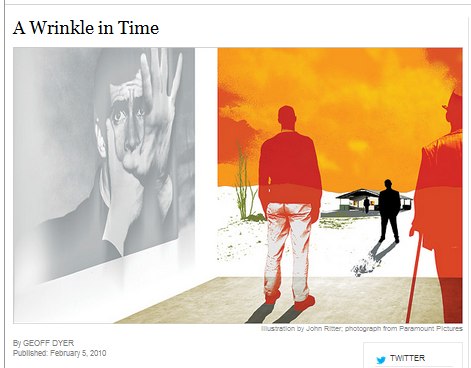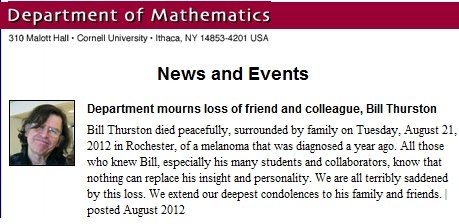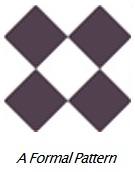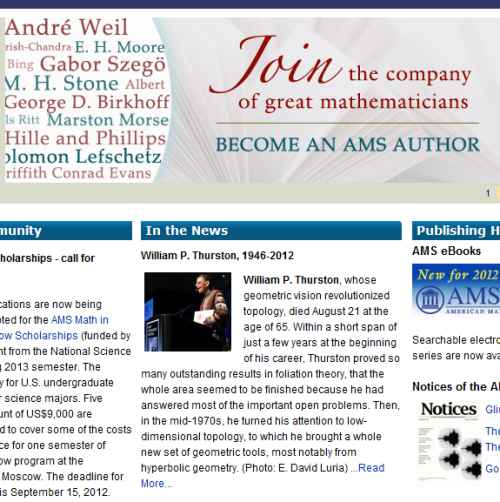Monday, May 27, 2019
Misery Emissary: A Thurston Memorial
Monday, March 13, 2023
Frontiers of Artificial Mathematics
Previous posts have shown ChatGPT answering the question
"What is the diamond theorem?" with references to Thurston
and, later, to Conway. Today it is Penrose's turn.

Related search results (click to enlarge) —
Sunday, March 5, 2023
Annals of Artificial Mathematics
The response of ChatGPT to a question about my work
continues to evolve. It now credits Conway, not Thurston,*
for the diamond theorem.

The paragraph beginning "The theorem states" appears** to be based
on the following 24 patterns — which number only 8, if rotated or
reflected patterns are considered equivalent.
* For Thurston in an earlier ChatGPT response to the same question,
see a Log24 post of Feb. 25.
** The illustration above is based on the divison of a square into
four smaller subsquares. If the square is rotated by 45 degrees,
it becomes a diamond that can be, in the language of ChatGPT,
divided into "four smaller diamonds ."
Saturday, February 25, 2023
The Diamond Theorem according to ChatGPT

The part about tilings, group actions, and the diamond-shaped
pattern is more or less OK. The parts about Thurston and
applications are utterly false.
Compare and contrast . . .


Sunday, October 20, 2019
Saturday, January 5, 2019
Cornell Geometry
See Thurston + Cornell and Henderson + Cornell.
This post was suggested by the latter.
Sunday, December 16, 2018
Inaction Illustrated
See "Inaction Film," a Log24 post of August 21, 2012 —
the date of death for one William P. Thurston.
Sunday, December 2, 2018
Symmetry at Hiroshima
A search this morning for articles mentioning the Miracle Octad Generator
of R. T. Curtis within the last year yielded an abstract for two talks given
at Hiroshima on March 8 and 9, 2018 —
|
http://www.math.sci.hiroshima-u.ac.jp/ branched/files/2018/abstract/Aitchison.txt
Iain AITCHISON Title: Construction of highly symmetric Riemann surfaces, related manifolds, and some exceptional objects, I, II Abstract: Since antiquity, some mathematical objects have played a special role, underpinning new mathematics as understanding deepened. Perhaps archetypal are the Platonic polyhedra, subsequently related to Platonic idealism, and the contentious notion of existence of mathematical reality independent of human consciousness. Exceptional or unique objects are often associated with symmetry – manifest or hidden. In topology and geometry, we have natural base points for the moduli spaces of closed genus 2 and 3 surfaces (arising from the 2-fold branched cover of the sphere over the 6 vertices of the octahedron, and Klein's quartic curve, respectively), and Bring's genus 4 curve arises in Klein's description of the solution of polynomial equations of degree greater than 4, as well as in the construction of the Horrocks-Mumford bundle. Poincare's homology 3-sphere, and Kummer's surface in real dimension 4 also play special roles. In other areas: we have the exceptional Lie algebras such as E8; the sporadic finite simple groups; the division algebras: Golay's binary and ternary codes; the Steiner triple systems S(5,6,12) and S(5,8,24); the Leech lattice; the outer automorphisms of the symmetric group S6; the triality map in dimension 8; and so on. We also note such as: the 27 lines on a cubic, the 28 bitangents of a quartic curve, the 120 tritangents of a sextic curve, and so on, related to Galois' exceptional finite groups PSL2(p) (for p= 5,7,11), and various other so-called `Arnol'd Trinities'. Motivated originally by the `Eightfold Way' sculpture at MSRI in Berkeley, we discuss inter-relationships between a selection of these objects, illustrating connections arising via highly symmetric Riemann surface patterns. These are constructed starting with a labeled polygon and an involution on its label set. Necessarily, in two lectures, we will neither delve deeply into, nor describe in full, contexts within which exceptional objects arise. We will, however, give sufficient definition and detail to illustrate essential inter-connectedness of those exceptional objects considered. Our starting point will be simplistic, arising from ancient Greek ideas underlying atomism, and Plato's concepts of space. There will be some overlap with a previous talk on this material, but we will illustrate with some different examples, and from a different philosophical perspective. Some new results arising from this work will also be given, such as an alternative graphic-illustrated MOG (Miracle Octad Generator) for the Steiner system S(5,8,24), and an alternative to Singerman – Jones' genus 70 Riemann surface previously proposed as a completion of an Arnol'd Trinity. Our alternative candidate also completes a Trinity whose two other elements are Thurston's highly symmetric 6- and 8-component links, the latter related by Thurston to Klein's quartic curve. |
See also yesterday morning's post, "Character."
Update: For a followup, see the next Log24 post.
Saturday, November 21, 2015
Visionary
Two figures to whom the word "visionary" has
recently been applied —
Paul Laffoley at news.artnet.com
William P. Thurston at AMS Notices (Dec. 2015)
A more classic example of a visionary is, of course, William Blake.
Monday, September 17, 2012
Pattern Conception
( Continued from yesterday's post FLT )
Context Part I —
"In 1957, George Miller initiated a research programme at Harvard University to investigate rule-learning, in situations where participants are exposed to stimuli generated by rules, but are not told about those rules. The research program was designed to understand how, given exposure to some finite subset of stimuli, a participant could 'induce' a set of rules that would allow them to recognize novel members of the broader set. The stimuli in question could be meaningless strings of letters, spoken syllables or other sounds, or structured images. Conceived broadly, the project was a seminal first attempt to understand how observers, exposed to a set of stimuli, could come up with a set of principles, patterns, rules or hypotheses that generalized over their observations. Such abstract principles, patterns, rules or hypotheses then allow the observer to recognize not just the previously seen stimuli, but a wide range of other stimuli consistent with them. Miller termed this approach 'pattern conception ' (as opposed to 'pattern perception'), because the abstract patterns in question were too abstract to be 'truly perceptual.'….
…. the 'grammatical rules' in such a system are drawn from the discipline of formal language theory (FLT)…."
— W. Tecumseh Fitch, Angela D. Friederici, and Peter Hagoort, "Pattern Perception and Computational Complexity: Introduction to the Special Issue," Phil. Trans. R. Soc. B (2012) 367, 1925-1932
Context Part II —
Context Part III —
A four-color theorem describes the mathematics of
general structures, not just symbol-strings, formed from
four kinds of things— for instance, from the four elements
of the finite Galois field GF(4), or the four bases of DNA.
Context Part IV —
A quotation from William P. Thurston, a mathematician
who died on Aug. 21, 2012—
"It may sound almost circular to say that
what mathematicians are accomplishing
is to advance human understanding of mathematics.
I will not try to resolve this
by discussing what mathematics is,
because it would take us far afield.
Mathematicians generally feel that they know
what mathematics is, but find it difficult
to give a good direct definition.
It is interesting to try. For me,
'the theory of formal patterns'
has come the closest, but to discuss this
would be a whole essay in itself."
Related material from a literate source—
"So we moved, and they, in a formal pattern"
Formal Patterns—
Not formal language theory but rather
finite projective geometry provides a graphic grammar
of abstract design—
See also, elsewhere in this journal,
Crimson Easter Egg and Formal Pattern.
Friday, August 31, 2012
Translation
"Translation in the direction
conceptual -> concrete and symbolic
is much easier than
translation in the reverse direction…."
— The late William P. Thurston
(See also "Atlas to the Text," Harvard Crimson , March 8, 2011).
Related cinematic imagery
Conceptual (thanks to Don DeLillo and The New York Times )—
Concrete and symbolic (thanks to Amy Adams and Emily Blunt, as well as
Frederick Seidel in the September 3, 2012, New Yorker )—
"Biddies still cleaned the student rooms."
Wednesday, August 29, 2012
Hexagram 18
(Continued from June 14, 2007)
The late William P. Thurston on how mathematical knowledge may decay:
"There are several obvious mechanisms of decay. The experts in a subject retire and die, or simply move on to other subjects and forget. Mathematics is commonly explained and recorded in symbolic and concrete forms that are easy to communicate, rather than in conceptual forms that are easy to understand once communicated. Translation in the direction
In short, mathematics only exists in a living community of mathematicians that spreads understanding and breaths [sic ] life into ideas both old and new. The real satisfaction from mathematics is in learning from others and sharing with others. All of us have clear understanding of a few things and murky concepts of many more. There is no way to run out of ideas in need of clarification. The question of who is the first person to ever set foot on some square meter of land is really secondary. Revolutionary change does matter, but revolutions are few, and they are not
— At mathoverflow.net, October 30, 2010.
The discussion has been "closed as no longer relevant."
For another Thurston quote of interest, see a more recent
mathoverflow discussion "closed as not a real question."
Monday, August 27, 2012
Touchy-Feely
A remark by the late William P. Thurston—
Please note: I'm not advocating that
we turn mathematics into a touchy-feely subject.
Noted. But see this passage—
|
The Mathematical Experience , by Philip J. Davis and Reuben Hersh (1981), updated study edition, Springer, 2011— From the section titled "Four-Dimensional Intuition," pages 445-446: "At Brown University Thomas Banchoff, a mathematician, and Charles Strauss, a computer scientist, have made computer-generated motion pictures of a hypercube…. … at the Brown University Computing Center, Strauss gave me a demonstration of the interactive graphic system which made it possible to produce such a film…. … Strauss showed me how all these controls could be used to get various views of three-dimensional projections of a hypercube. I watched, and tried my best to grasp what I was looking at. Then he stood up, and offered me the chair at the control. I tried turning the hypercube around, moving it away, bringing it up close, turning it around another way. Suddenly I could feel it!. The hypercube had leaped into palpable reality, as I learned how to manipulate it, feeling in my fingertips the power to change what I saw and change it back again. The active control at the computer console created a union of kinesthetics and visual thinking which brought the hypercube up to the level of intuitive understanding." |
Thanks to the Web, a version of this experience created by Harry J. Smith
has been available to non-academics for some time.

Friday, August 24, 2012
Formal Pattern
(Continued from In Memoriam (Aug. 22), Chapman's Homer (Aug. 23),
and this morning's Colorful Tale)
An informative, but undated, critique of the late Marvin W. Meyer
by April D. DeConick at the website of the Society of Biblical Literature
appeared in more popular form in an earlier New York Times
op-ed piece, "Gospel Truth," dated Dec. 1, 2007.
A check, in accord with Jungian synchronicity, of this journal
on that date yields a quotation from Plato's Phaedrus —
"The soul or animate being has the care of the inanimate."
Related verses from T. S. Eliot's Four Quartets —
"The detail of the pattern is movement."
"So we moved, and they, in a formal pattern."
Some background from pure mathematics (what the late
William P. Thurston called "the theory of formal patterns")—
Wednesday, August 22, 2012
In Memoriam
A quotation from William P. Thurston,
who died yesterday—
"It may sound almost circular to say that
what mathematicians are accomplishing
is to advance human understanding of mathematics.
I will not try to resolve this
by discussing what mathematics is,
because it would take us far afield.
Mathematicians generally feel that they know
what mathematics is, but find it difficult
to give a good direct definition.
It is interesting to try. For me,
'the theory of formal patterns'
has come the closest, but to discuss this
would be a whole essay in itself."
Related material from a literate source—
"So we moved, and they, in a formal pattern"
— and from a different source, cached shortly after midnight
on the (GMT) date of Thurston's death —
(Click for Google Cache information and to enlarge.)
Detail from the above Math Overflow discussion—
Saturday, January 20, 2007
Saturday January 20, 2007
| California | /90871732/item.html | 1:14 PM |
| California | /364492065/item.html | 1:06 PM |
| California | /365894946/item.html | 1:04 PM |
| California | /13339976/item.html | 1:04 PM |
| California | /543036518/item.html | 12:59 PM |
| California | /554871237/notes-for-ch… | 12:55 PM |
| California | /542741247/for-william-… | 12:52 PM |
| California | /language.aspx?returnur… | 12:51 PM |
| California | /33631118/item.html | 12:50 PM |
| California | /90556045/item.html | 12:36 PM |
Tuesday, October 31, 2006
Tuesday October 31, 2006

"Card tricks can be used
to liven up many classes
for mathematics students."
… or Treat?

Related material:
yesterday's entry.
Tuesday, October 24, 2006
Tuesday October 24, 2006
of the previous entry's concept of
a "critical mass" of weblog entries,
a concept reflected in
the saying
"You can't win the lottery
if you don't buy a ticket."
Mathematics and Narrative:
A Two-Part Invention
Here are today's
numbers from the
Keystone State:

of those numbers:
The second sentence, in bold type, was added on 8/21 by yours truly. No deep learning or original thought was required to make this important improvement in the article; the sentence was simply copied from the then-current version of the article on Grigori Perelman (who has, it seems, proved the geometrization conjecture).
This may serve as an example of the "mathematics" part of the above phrase "Mathematics and Narrative" — a phrase which served, with associated links, as the Log24 entry for 8/21.
7/23 — Narrative:
This quotation appeared in the Log24 entry for 7/23, "Dance of the Numbers." What Dyson calls a "story" or "drama" is in fact mathematics. (Dyson calls the "steps" in the story "works of art," so it is clear that Dyson (a former student of G. H. Hardy) is discussing mathematical steps, not paragraphs in someone's account– perhaps a work of art, perhaps not– of mathematical history.) I personally regard the rhetorical trick of calling the steps leading to a mathematical result a "story" as contemptible vulgarization, but Dyson, as someone whose work (pdf) led to the particular result he is discussing, is entitled to dramatize it as he pleases.
For related material on mathematics, narrative, and vulgarization, click here.
The art of interpretation (applied above to a lottery) is relevant to narrative and perhaps also, in some sense, to the arts of mathematical research and exposition (if not to mathematics itself). This art is called hermeneutics.
For more on the subject, see the Stanford Encyclopedia of Philosophy article on Hans-Georg Gadamer, "the decisive figure in the development of twentieth-century hermeneutics."
"Foreword" in Gian-Carlo Rota,
Indiscrete Thoughts,
Boston: Birkhäuser Verlag,
1996, xiii-xvii, and
"Gadamer's Theory of Hermeneutics" in
The Philosophy of Hans-Georg Gadamer,
edited by Lewis E. Hahn,
The Library of Living Philosophers, Vol. 24,
Chicago: Open Court Publishers,
1997, 223-34.
Tuesday, August 22, 2006
Tuesday August 22, 2006
Introductions
In talks at Valencia, Spain, in May through August of 2004, Alexander Borisenko, of Kharkov National University in the Ukraine, provided a detailed introduction to the topic of today’s opening lecture at ICM 2006 in Madrid:
An Introduction to Hamilton and Perelman’s Work on the Conjectures of Poincare and Thurston (pdf, 155 pages).
For a less detailed introduction, see an ICM 2006 press release (pdf, 3 pages) on Fields Medal winner Grigory Perelman.
Related material: The previous entry, “Beginnings,” and an introduction to the second-simplest two-dimensional geometry (Balanchine’s Birthday, 2003).
“How much story do you want?”
— George Balanchine
Tuesday August 22, 2006
Beginnings
“Nothing ever begins.
There is no first moment; no single word or place from which this or any other story springs.
The threads can always be traced back to some earlier tale, and to the tales that preceded that; though as the narrator’s voice recedes the connections will seem to grow more tenuous, for each age will want the tale told as if it were of its own making.”
— Clive Barker, Weaveworld
“No mathematical subject lies closer to intuition than the geometry of two and three dimensions.”
— Robert E. Greene, beginning an April 1998 review of Three-Dimensional Geometry and Topology, by William P. Thurston
Thurston’s book provides some background for today’s opening lecture by Richard Hamilton, “The Poincare Conjecture,” at the beginning of the International Congress of Mathematicians in Madrid.
Hamilton is likely to discuss the Poincare conjecture in the wider context of Perelman‘s recent work on Thurston’s geometrization conjecture.
In “The Eight Model Geometries,” section 3.8 of his book, Thurston provides yet another beginning–














